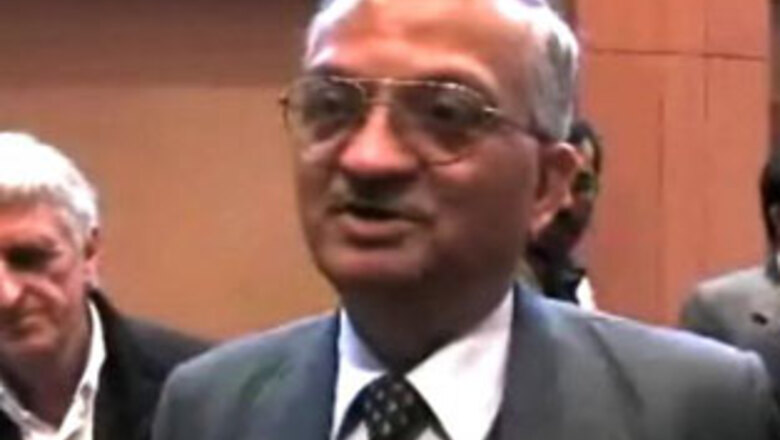
views
Mumbai: Rubbishing doubts on the efficacy of the hydrogen bomb test in 1998, Atomic Energy Commission Chairman Anil Kakodkar today said scientists have achieved success in building deterrence capability of upto 200 kilotons.
"Once again I would like to re-emphasise that the 1998 nuclear tests were fully successful. We had achieved all the objectives in totality."
"It has given us the capability to build deterrence based on both fission and thermonuclear weapon systems from modest to all the way upto 200 kilotons," he said addressing a press conference here.
Kakodkar, who was Director of the Bhabha Atomic Research Centre in 1998, termed as "unnecessary" the controversy over the Pokhran-II nuclear tests triggered after claims by a former DRDO scientist that the hydrogen bomb experiment was a failure.
R Chidambaram, Chairman of the AEC in 1998 and the current Principal Scientific Adviser to the Union Government, made a presentation on the results of the Pokhran-II nuclear tests.
Former DRDO scientist K Santhanam, who was the DRDO coordinator for the 1998 tests, had claimed that the thermonuclear test was much below expectation triggering a controversy.Santhanam had also demanded an inquiry by an independent panel of experts into the test results.
Both Kakodkar and Chidambaram termed as "unnecessary", the row triggered by the remarks of Santhanam, a former DRDO scientist and a coordinator of the nuke tests and said "we are perplexed by the controversy."
"We are saddened that two of our colleagues used heavy rhetoric which is not substitute of good science," Chidambaram, who was accompanied by several BARC scientists, including its director S Banerjee, said.
"Culture of science is to have discussions in the scientific fora or peer reviewed scientific journals and they (Santhanam and former AEC Chairman and India's top physicist P K Iyengar) should have understood the proliferation sensitive nature of the information," he said.
"No one in this business would do that and our Bhabha Atomic Research Centre scientists are doing progressive work in the strategic area for the past 11 years and we are confident about the design of the device," Chidambaram said.
Santhanam had also demanded an enquiry by an independent panel of experts into the test results.
PAGE_BREAK
Explaining how the two-stage device needed a thorough understanding of advanced seismology and radiochemistry, Chidambaram said "our results were so accurate that we disclosed the yield on the same day of the explosion which no other country has done as science has evolved in the last two decades."
The results were presented before the Atomic Energy Commission four times (Chidambaram was then the Chairman) where Raja Ramanna, father of India's nuclear bomb of 1974, was a member, Chidambaram said.
To the doubt about the yield raised by Santhanam and Ashok Parthasarathy that 'the fission bomb yield from DRDO's seismic instrumentation was 25 kiloton', Chidambaram said, "the BARC estimate of the yield for the fission device is 15 kiloton (and not 25 kiloton) and for the thermonuclear device 45 kiloton."
One of the methods used for the estimation of the device yield was close-in acceleration measurement, for which both the DRDO and BARC had set up instrumentation, he said.
It soon became apparent after discussion among the two groups of specialists that the DRDO data had anomalies and had to be rejected and that the BARC data, which had the expected waveforms, would be accepted, he said.
Chidambaram said, "the important point is that P K Iyengar does not dispute the yield of thermonuclear test."
Iyengar, however, raised doubts about the efficiency of the bomb in 2000 and repeated recently ---- 'in my opinion that ratio of fission fission to fusion energy must have been around 1:1...therefore, by my best estimate, the fusion yield could not have been more than 20 kiloton...this suggests that the fusion core burnt only partially, perhaps less than 10 per cent..'.
Responding to this doubt, Chidambaram said to understand the efficiency of the bomb, one has to be closely associated with the design, material and quantity of material.
"We do not understand how without the knowledge of the design and therefore, without knowledge of the fusion-fission break-up and the quantity of thermonuclear material in the device and its isotopic composition, he has tried to calculate the efficiency of the fusion burn," he said.
On another doubt of Santhanam that "the fission bomb left a crater 25 metre in diameter and if the thermonuclear device had really worked with a yield of 50 kiloton, it should have left a crater almost 70 metre in diameter," Chidambaram said, the surface feature producing a Ground Zero depends on the depth of burial and rock medium around the shot point.
"It also depends on the rock medium between the shot point and the ground," he said, adding the geology of Pokhran is inhomogeneous and the propagation of the shock wave due to explosion is affected by every interface.
When asked why the depth of the placing of the device was not disclosed in the peer reviewed papers as was done by BARC scientists in 1974 Pokhran I, Chidambaram said, "1974 test was a peaceful nuclear experiment and it is a global practice to give more details but the 1998 device was a nuclear weapon
device and the information about it is proliferation sensitive.


















Comments
0 comment